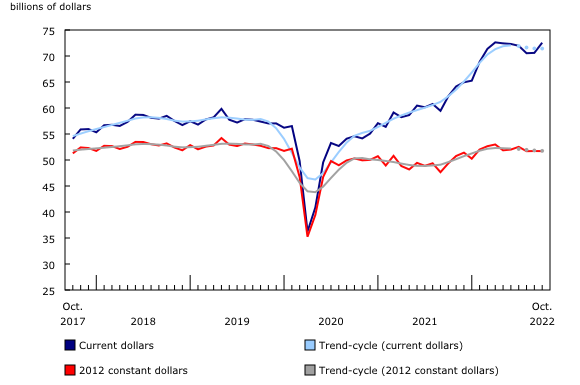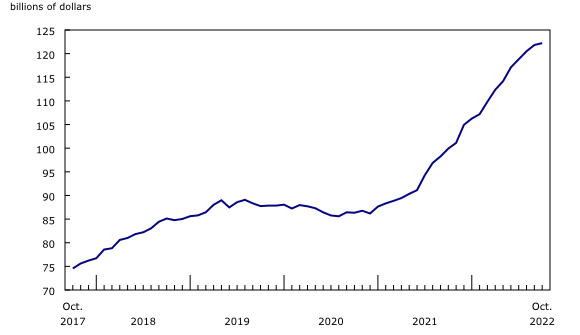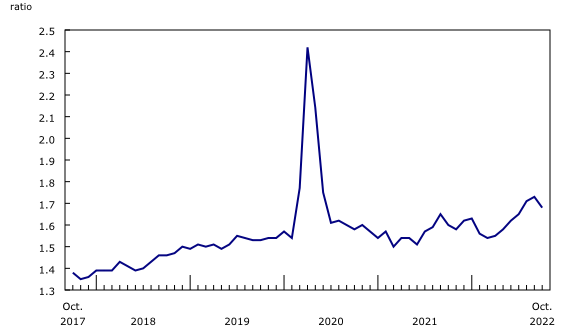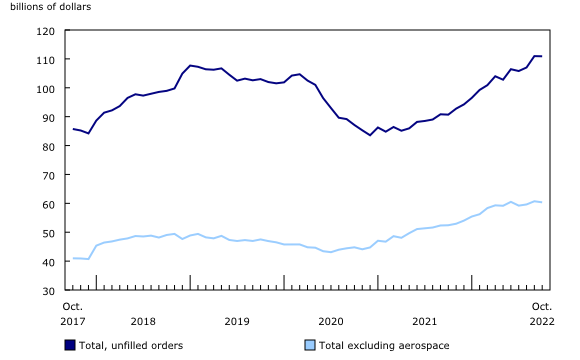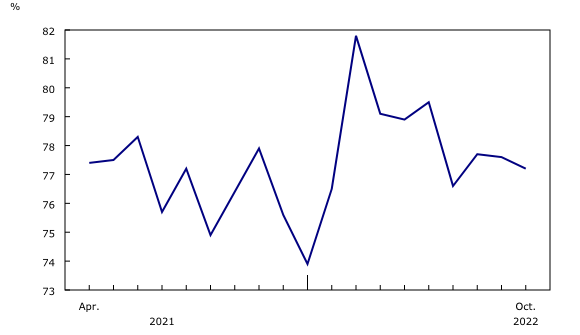Monthly Survey of Manufacturing, October 2022
Released: 2022-12-14
Manufacturing sales rose 2.8% to $72.6 billion in October. Sales increased in 12 of 21 industries, led by the petroleum and coal (+12.7%), food (+2.9%), chemical (+4.9%) and miscellaneous manufacturing (+13.3%) industries. Meanwhile, motor vehicles (-3.2%) and machinery (-1.7%) posted the largest monthly declines. Compared with the same month last year, total sales were up 16.5%.
Sales in constant dollars were unchanged in October, indicating that the entire increase in current dollar sales was driven by higher prices as the Industrial Product Price Index rose 2.4% in October.
Petroleum and coal industry posts the largest increase
After four consecutive monthly declines, sales in the petroleum and coal industry rose 12.7% to $10.6 billion in October, on higher prices and some volume growth (+2.1%). Prices of refined petroleum energy products (including liquid fuels) increased 14.9% in October, after four consecutive monthly declines, while exports of refined petroleum energy products were up 6.8%. The increases were likely related to anticipations of a lower crude oil supply—a feedstock for refined petroleum energy products—going forward as the Organization of the Petroleum Exporting Countries Plus (OPEC+) imposed a production cut for November.
Sales in the food manufacturing industry reached a record high in October, rising 2.9% to $12.3 billion. Year over year, sales were up 12.1%. The increase was mainly driven by gains in the grain and oilseed milling industry which increased 18.4% to $2.0 billion in October, a record high level. Prices (+7.7%) and volume (+10.6%) of canola oil were both up. In addition, exports of canola (+73.8%) and wheat (+18.0%) both rose. Persistent inflation and high global demand amid considerable uncertainty after the Russian invasion of Ukraine have contributed to the gains observed. Sales in constant dollars increased 0.7% in October.
Sales of chemical products rose for the second consecutive month, up 4.9% to $6.1 billion in October, mainly attributable to an increase in the pesticide, fertilizer and other agricultural industry (+98.1%). The increase was associated with a strong seasonal demand and worldwide supply shortage due to sanctions aimed at Russia and Belarus to prevent these two major fertilizer exporters from reaching global markets. Exports of potash—primarily used in fertilizers—were up 15.4% in October, while prices for pesticides and fertilizers rose 3.5%. Despite the monthly increase in current dollars, sales in real terms declined 0.3%.
Other industries that increased in October were the miscellaneous manufacturing (+13.3%), paper product (+2.4%) and motor vehicle parts (+2.2%) industries.
Sales of motor vehicles posted the largest decline in October, falling 3.2% to $3.4 billion. Lack of materials and microchip shortages continue to plague several auto manufactures. Exports of motor vehicles and parts were down 1.8% in October.
Other industries that declined in October were the machinery (-1.7%), wood (-1.8%) and primary metal (-0.8%) industries.
Sales in Alberta increase the most
In October, sales rose in seven provinces, led by Alberta, Quebec and Ontario. The increases were partly offset by lower sales in British Columbia.
In Alberta, sales rose 7.3% to a record high of $9.5 billion in October, after four consecutive monthly declines. The growth was led by petroleum and coal products (+13.7%), which experienced the second largest (in dollar terms) monthly increase in the province, as well as the chemical product industry (+14.9%) which recorded the largest increase. Year over year, total sales in the province were up 29.5%.
In Quebec, sales rose 3.3% to $18.2 billion in October, mostly on higher sales in the petroleum and coal product (+19.9%) and paper product (+10.5%) industries, while sales in wood products (-4.0%) saw the largest decline. Year over year, total sales in the province increased 16.2%.
Following a 1.0% decline in September, sales in Ontario increased 1.7% to $31.1 billion in October, primarily on higher sales of petroleum and coal product (+11.9%) and miscellaneous manufacturing (+15.7%), namely in the jewelry and silverware industry as there were significant increases in the exports of gold coin and precious metal to the United States. The gains in total sales were primarily offset by lower sales in the motor vehicle industry (-3.4%). Compared with the same month last year, total sales in the province rose 12.9%.
In British Columbia, sales were down 1.2% to $5.7 billion in October, primarily on lower sales of durable goods (-4.7%) led by the primary metal industry (-18.8%), while sales of non-durable products increased (+2.9%). Despite the monthly decline, total sales in the province increased 9.8% year over year.
Québec recorded the highest sales
Sales increased in 8 of 15 selected census metropolitan areas in October, led by Québec (+14.6%) and Edmonton (+4.5%), while Kitchener–Cambridge–Waterloo (-11.9%) saw the largest decline.
After four consecutive monthly declines, sales in Québec rose 14.6% to $2.4 billion in October, almost entirely driven by higher sales in the petroleum and coal industry and partly offset by lower sales in the beverage and tobacco industry.
Sales in Edmonton rose 4.5% to $4.7 billion in October, following three consecutive monthly declines, led by the petroleum and coal product industry (+5.9%). Year over year, total sales increased 51.0%.
Sales in Kitchener–Cambridge–Waterloo declined 11.9% to $2.1 billion in October, largely attributable to lower sales of motor vehicles, following two consecutive months of growth. Despite the monthly decline, total sales increased 10.0% on a year-over-year basis.
Inventory level expand at a slower pace
Total inventory levels increased at their lowest monthly pace, in dollar terms, since March 2021, edging up 0.3% to $122.2 billion in October, on higher prices as the volume of inventory levels dipped 0.8% in the same month. The gains were led by the primary metal (+2.8%), plastics and rubber (+2.6%) and wood product (+1.8%) industries and were partly offset by lower inventories in the aerospace product and parts (-2.9%), fabricated metal (-1.9%) and food (-1.1%) industries. Raw materials (+0.7%) as the largest component of the inventory contributed the most to the monthly gains, while finished products (+0.1%) and goods in process (+0.1%) changed little. Year over year, total inventory levels rose 22.3%.
The inventory-to-sales ratio fell from 1.73 in September to 1.68 in October. This ratio measures the time, in months, that would be required to exhaust inventories if sales were to remain at their current level.
Unfilled orders remain unchanged
Total value of the unfilled orders remained unchanged in October at $110.9 billion, as higher unfilled orders in the aerospace product and parts (+0.6%) and fabricated metal (+2.8%) industries were largely offset by lower unfilled orders in the computer and electronic product (-3.9%) and primary metal (-5.5%) industries.
The total value of new orders decreased 2.7% to $72.5 billion in October, mostly on lower new orders in the transportation equipment industry (-27.4%) and were partly offset by higher new orders in the petroleum and coal product industry (+12.7%).
Capacity utilization rate falls
The capacity utilization rate (not seasonally adjusted) for the manufacturing sector was down from 77.6% in September to 77.2% in October.
The capacity utilization rate decreased in 13 of 21 industries in October, notably in the primary metal (-5.0 percentage points), computer and electronic product (-2.4 percentage points) and transportation equipment (-1.4 percentage points) industries.
The decreases were partially offset by a higher capacity utilization rate in the petroleum and coal product (+3.3 percentage points) and chemical (+1.6 percentage points) industries.
Sustainable development goals
On January 1, 2016, the world officially began implementing the 2030 Agenda for Sustainable Development—the United Nations' transformative plan of action that addresses urgent global challenges over the following 15 years. The plan is based on 17 specific sustainable development goals.
The Monthly Survey of Manufacturing is an example of how Statistics Canada supports the reporting on the global sustainable development goals. This release will be used to help measure the following goal:

Note to readers
Monthly data in this release are seasonally adjusted and are expressed in current dollars, unless otherwise specified.
Seasonally adjusted data are data that have been modified to eliminate the effect of seasonal and calendar influences to allow for more meaningful comparisons of economic conditions from period to period. For more information on seasonal adjustment, see Seasonally adjusted data – Frequently asked questions.
Trend-cycle estimates are included in selected charts as a complement to the seasonally adjusted series. These data represent a smoothed version of the seasonally adjusted time series and provide information on longer-term movements, including changes in direction underlying the series. For information on trend-cycle data, see Trend-cycle estimates – Frequently asked questions.
Both seasonally adjusted data and trend-cycle estimates are subject to revision as additional observations become available. These revisions could be large and could even lead to a reversal of movement, especially for reference months near the end of the series or during periods of economic disruption.
Non-durable goods industries include food; beverage and tobacco products; textile mills; textile product mills; clothing; leather and allied products; paper; printing and related support activities; petroleum and coal products; chemicals; and plastics and rubber products.
Durable goods industries include wood products; non-metallic mineral products; primary metals; fabricated metal products; machinery; computer and electronic products; electrical equipment, appliances and components; transportation equipment; furniture and related products; and miscellaneous manufacturing.
Production-based industries
For the aerospace and shipbuilding industries, the value of production is used instead of the value of sales of goods manufactured. The value of production is calculated by adjusting monthly sales of goods manufactured by the monthly change in inventories of goods in process and finished products manufactured. The value of production is used because of the extended period of time that it normally takes to manufacture products in these industries.
Unfilled orders are a stock of orders that will contribute to future sales, assuming that the orders are not cancelled.
New orders are those received, whether sold in the current month or not. New orders are measured as the sum of sales for the current month plus the change in unfilled orders from the previous month to the current month.
Manufacturers reporting sales, inventories and unfilled orders in US dollars
Some Canadian manufacturers report sales, inventories and unfilled orders in US dollars. These data are then converted to Canadian dollars as part of the data production cycle.
For sales, based on the assumption that they occur throughout the month, the average monthly exchange rate for the reference month established by the Bank of Canada is used for the conversion. The monthly average exchange rate is available in table 33-10-0163-01. Inventories and unfilled orders are reported at the end of the reference period. For most respondents, the daily average exchange rate on the last working day of the month is used for the conversion of these variables.
However, some manufacturers choose to report their data as of a day other than the last working day of the month. In these instances, the daily average exchange rate on the day selected by the respondent is used. Note that because of exchange rate fluctuations, the daily average exchange rate on the day selected by the respondent can differ from both the exchange rate on the last working day of the month and the monthly average exchange rate. Daily average exchange rate data are available in table 33-10-0036-01.
Revision policy
Each month, the Monthly Survey of Manufacturing releases preliminary data for the reference month and revised data for the previous three months. Revisions are made to reflect new information provided by respondents and updates to administrative data.
Once a year, a revision project is undertaken to revise multiple years of data.
Real-time data tables
Real-time data tables 16-10-0118-01, 16-10-0119-01, 16-10-0014-01 and 16-10-0015-01 will be updated on December 22.
Next release
Data from the Monthly Survey of Manufacturing for November 2022 will be released on January 16, 2023.
Contact information
For more information, or to enquire about the concepts, methods or data quality of this release, contact us (toll-free 1-800-263-1136; 514-283-8300; infostats@statcan.gc.ca) or Media Relations (statcan.mediahotline-ligneinfomedias.statcan@statcan.gc.ca).
- Date modified:



